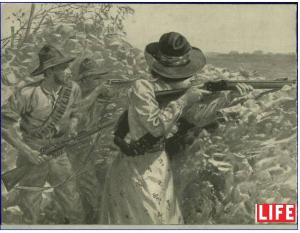25 Jul 2010
The Chess Players
Image posted HERE with more information about the sculpture. The link to the map is where you can view the sculpture in Washington, DC.
View Larger Map
Just the music for a relaxing chess game!
3 Jul 2010
Churchill makes me smile

Boer Scouts in Natal

Father and son go to war - image: diggershistory.info

How I love thee...to read these quotes - you can read similar quotes on my other link in this post.[The Boer War link on my blog]
When the world loved the Boers...
WHEN IN OCTOBER 1899 the British Empire went to war against the Boers or Afrikaners of the Transvaal (South African Republic) and the Orange Free State, it was widely believed that the conflict would be brief. It became, however, the largest war waged by Britain since the Napoleonic Wars, even including the Crimea, involving the strongest forces sent from English shores since Henry V's army departed for Agincourt. It was the first of the modern media wars, waged for the hearts and minds of both metropolitan and global opinion, in which military officers and civilian politicians on all sides had to pay acute attention to the coverage provided by the press. Fought at a time when the telegraph and syndicated news agencies had begun to globalise information, it became the most publicised war waged outside Europe between the American Civil War and the First World War. Indeed, in the minds of contemporaries, the South African War shared certain similarities with the American conflict, not least the widespread perception that it involved universal issues and principles which extended far beyond the borders of southern Africa.The Guinness Book of Records lists the Anglo-Boer War as Britain's most costly war outside of the two World Wars.
Imperialists in Britain and its colonies of settlement believed the very essence of British strength to be at stake. Thousands of volunteers from Canada, Australia and New Zealand flocked to the imperial colours in South Africa. Britain, however, was made to appear both militarily and physically degenerate by the three years and almost half-a-million men it took to defeat the Boers, whose forces never numbered more than 88,000. During the guerrilla phase of the war, between June 1900 and the Boer surrender in May 1902, the tactics of farm burning and concentration camps employed by the British added further charges of brutality and moral corruption before the bar of world opinion. The significance of the Transvaal goldfields and the political prominence of leading magnates, often caricatured as a bloated Cecil Rhodes, gave the war a whiff of the sordid, which opponents of the conflict were all too ready to exploit (even if the actual influence of capitalists in the outbreak of hostilities was and remains controversial). Meanwhile, the unexpected protraction of the struggle intensified calls for a complete reorganisation of British educational and industrial life and gave rise to that peculiar Edwardian imperialist soul-searching encapsulated under the catchphrase National Efficiency. The war polarised political opinion in Britain, where David Lloyd George, Emily Hobhouse and James Ramsay MacDonald were among its leading opponents. The war even affected the young Clement Attlee, then a schoolboy at Haileybury, who, along with the entire middle school, was beaten by his pro-Boer headmaster for taking part in a celebration of the relief of Ladysmith that he had banned. In Ireland, the war greatly deepened the alienation of unionists, whose imperialism was invigorated by the war from nationalists who were enthusiastically pro-Boer. In Canada, too, the conflict widened the gulf between French Canadian nationalists and their English-speaking countrymen and set the pattern of their future relationship. It intensified the imperialism of Australia where it appeared to herald the arrival of The Coming Man, that healthy Independent Australian Briton who represented an almost evolutionary improvement on his metropolitan ancestors, ensuring that the new federation was born with a conservative emblem of imperial sacrifice. Nevertheless, it also provided, in the form of `Breaker' Morant, executed for shooting prisoners, yet another Australian anti-hero. In India, the unwillingness of the British to employ Indian troops in a `Sahib's War', together with imperial failure to ensure Indian rights, further alienated moderate nationalists, while Indian advocates of physical force, like their Irish counterparts, came to admire Boer armed resistance. More generally, at the dawn of the twentieth century the war drew on a widespread, almost millenarian sense of angst about the future, manifested in such events as the Dreyfus Affair, the Fashoda Crisis, the Spanish-American War of 1898 and the Chinese Boxer Uprising in 1900.In Europe and America, where there was enormous interest in the war, and in the United Kingdom itself, there emerged vociferous movements loosely regarded as pro-Boer. These varied greatly in outlook, however, from those who favoured an immediate end to the war and conciliation with the Boers, to those, often represented by the Irish nationalists and continental movements generally, which looked forward to a British defeat. There were also ...
Source: Questia HERE. It will open in a new window.
Camouflage was first used in battle by the Boers, who used camouflaged trenches and adapted battledress to blend into treeless landscapes.
The Anglo-Boer War (1899-1902) was the first war of the 20th century and saw the introduction of trench warfare, the first large-scale use of concentration camps for non-combatants, and the most prolonged period of guerrilla warfare by a conquered nation's military against a victorious army.
Young Boer soldier with the name of Conrad...
I've decided it was time for a new post on the Boer War as this link on my blog is now stuffed with too much info on the South African/British War. I will now add new info and links to this new entry as I lost myself amongst concentration camps and battles and thought to find myself again, this time on board with Churchill! Yes, Churchill even made me ordering this book. I like his way of playing with words and he had a humorous way of putting his hand on paper. He made me smile a few times and I've quoted some bits here...he even dreamt about South Africa as the country where he saw his great-grandchildren could grow up...er..South Africa is the most beautiful country in the world..no wonder he thought so too...Churchill also made me smile where he writes about the soldiers and the casualties...and them thinking the Boers were defeated. Ha! England, together with Irish soldiers/Scots/ Welsh/Indian+Australian/NewZealand-soldiers+Canadian soldiers...and they fought this War over three years against an army the size of the population of Brighton, that makes you think! I also have with me another interestesting book...Battles of the Boer War - written by W B Pemberton...an English writer. A great book to read. This book is not written one-sided - as you will find most books written by English writers are, as they see it only from their perspective and colour it the way they want. One must also bear in mind, the Boers had no training in fighting wars, no orderly system was in place, whilst the British had the experience and the advantage of fighting battles was on their side! According to this Gutenberg-link, about 15000 Boers were actively taking part in the War as soldiers. Enjoy bits from Churchill's book..click on images to see a larger view. I must also add, this is the first book ever where I read the offensive word which we don't use in our country - for years now - to refer to a non-white person. It was quite weird reading it - especially in this book. Where Churchill refers to the Karoo, I was really smiling...could picture him thinking what he was thinking. I've quoted it here too. On the above link you will find images, poetry and art about the Boer War and thousands of links to other historical sites/links linking to the War. On this link you can read about my great grandad and the role he played during the war and the peace process. His grandad was also on the most wanted-list of the British and there was a price tag of £300 on his head! [cool!] Read on the link more...
On this link you will find more history about the War on the site of Ladysmith-history, also eyewitness-accounts.[I've now received my book - see the cover in the next image - which I've ordered]
From the book:
 The Boer War: Londton to Ladysmith Via Pretoria and Ian Hamilton's March by Winston Churchill
The Boer War: Londton to Ladysmith Via Pretoria and Ian Hamilton's March by Winston ChurchillChurchill's adventures of the first five months of the War. Churchill was eager for news...
At last news came through...Boers defeated, three battles, Penn Symonds killed...
Cape Town - 1 November 1899
We caught the Man Who Knew ...setting him halfway up a ladder on the hurricane deck...the man told his story quickly, with an odd quiver of excitement in his voice... then for the first time we heard of Elandslaagte, of Glencoe, of Rietfontein...Tell us about Mafeking...someone else said...It's a long list of casualties...the best officers in the world...Colonel Chisholme...Sherstone...Haldane...Barnes...and many more...
East London 5th November.

The train, which is built on the corridor system, runs smoothly over the rails, so smoothly, indeed, that I found no difficulty in writing. The sun is warm, the air keen and delicious. But the scenery would depress the most buoyant spirit. We climbed up the mountains during the night, and with the daylight we were in the middle of the Great Karroo, Wherefore was this miserable land of stone and scrub created? Huge mounds of crumbling rock, fashioned by the rains in the most curious and unexpected shapes, rise from the gloomy desert of the plain.
At Beaufort Wes grave news awaiting the Mail and we learnt about the capitulation of twelve hundred soldiers near Ladysmith.

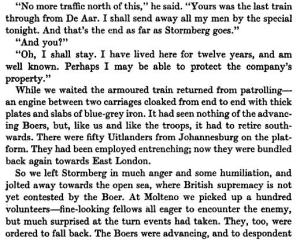
Churchill dreams about South Africa...
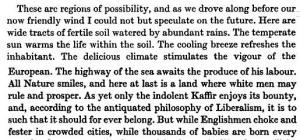


Boer soldiers ready for War - click for a larger view

"The war declared by the Boers on 11 October 1899 gave the British, as Kipling said, no end of a lesson'. The public expected it to be over by Christmas. It proved to be the longest (two and three-quarters years), the costliest (over two hundred million pounds), the bloodiest (at least 22,000 British, 25,000 Boer and 12,000 African lives) and the most humiliating war Britain fought between 1815 and 1914." - Thomas Pakenham: The Boer War
Image: Life - Women also took part in the war. In this post you will find the Gutenberg-link with photos from Women that played important roles during the war.
The young Winston Churchill
The news article about Churchill's captivity - in the Telegraph...image: genealogyworld.net - click on the image for a larger view.

A lovely chess set! I would love to have this one...
A French Hero...

Image: Wikipedia - Villebois-MareuilMy blogger-friend, Brandnetel, blogged today about Villebois-Mareuil and she had us all googled for Private E Brooks in her previous entry - as a secret mission! haha
From Wikipedia:[link at the bottom of this entry]
George Henri Anne-Marie Victor de Villebois-Mareuil (22 March 1847, Montaigu, Brittany, France - 6 April 1900, Boshof, Orange Free State, South Africa) was a Colonel in the French Infantry, and French Nationalist who fought and died on the side of the Boers during the Second Anglo-Boer War. He was the first of only two Boer foreign volunteers to be handed the grade of Major-General in the Boer Army. The second being his second in command Evgeni Maximov (1849-1904) after the death of Villebois-Mareuil. He took part in Franco-Prussian War - 1871 and drove back the Prussians from Blois.George Henri Anne-Marie Victor de Villebois-Mareuil was born approximately 30 km South East of Nantes. He was a soldier and author. He started his military education at the École Spéciale Militaire de Saint-Cyr where he graduated as a Second Lieutenant in 1867. He loved sport and excelled in gymnastics. Shortly after his graduation he left for Cochinchina where he joined the Marine Infantry serving under his uncle Admiral de Cornulier who was Governor of the Colony. He was promoted to full Lieutenant in 1870.
He saw in the Anglo-Boer War the chance to avenge the French humiliation at Fashoda in the Sudan in 1898.
"But she (England) can be sure that this tricolour flag, grabbed from Fachoda and ripped to shreds in London, was brought to Pretoria by French Volunteers, and has taken its place next to those of the Southern Boer Republics to support their independence against the oppressors. She gave us a Hundred Years' War, and for a hundred years she has robbed the farmers from the Cape. Since then she has violated every peace treaty. Her hatred being even fiercer against the Boer, for there is French blood flowing through their veins." - F. Chinier.
He arrived in Lourenço Marques on the 22 November 1899. In December 1899 he was appointed to the rank of Major by General Joubert, and fought in the Battle of Colenso. Due to his leadership capabilities he was given the rank of Major-General and commander of all Foreign Volunteers on 17 March 1900.
The average age of his troops was thirty with the youngest being Private Boiserolle who was only 17. He had a lot of respect for the fighting ability of the Germans under his command despite the lack of unity between the different German troops and commanders. He did not have the same convictions towards the Dutch under his command due to their apparent lack of courage and eagerness for battle. They were often referred to by the Boers themselves as lowly drunkards. - B. Lugan.
About the Boers he said:
He summed his thoughts about the Boer as follows: "Noble and of good race for the most, they live on their farm like in the castles of old, free and isolated... These people are standing up in the face of the whole world defying the decline of our too advanced civilizations." - La Liberté.Read Here more about the hero - Villebois-Mareuil.
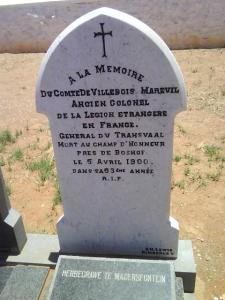
The Gravestone of Villebois-Mareuil. He was reintered at Magersfontein - Photo: Brandnetel
"When is a war not a war?" with "When it is carried on by methods of barbarism in South Africa," referring to those same camps and the policies that created them.
Read more here.
image: stanford university
This next book is a must read - [I said to myself]

Sarah Raal, deserves to have had a film made of her life. Born into a prosperous farm family in the Southern Free State outside Jagersfontein, with the outbreak of war her father and four brothers immediately enlisted leaving Sarah, her mother and two small children alone on the farm. On one occasion, when the latter were shopping in Jagersfontein, her mother was denounced for feeding passing Boers and, together with her children, placed in a concentration camp. This left Sarah alone on the farm with her farm workers. After seven months of this, her brothers suddenly appeared seeking sanctuary. Word of this got out, but they all got away before their arrest could be carried out. For a few months Sarah moved from farm to farm but inevitably her luck ran out and she was incarcerated at Springfontein. There she had a run-in with the Camp Commandant that resulted in her being placed in a punishment detail from which she escaped to rejoin her brothers. As the countryside was palpably unsafe for a woman alone, she was allowed to enlist with the commando under command of a Commandant Nieuwoudt. There she took part in a number of guerrilla engagements, coming under both rifle and shell fire several times and displaying considerable bravery during the course of these actions. On more than one occasion she was in actual physical combat with the enemy, narrowly escaping injury, death or capture. She was eventually captured in an ambush and placed in a camp until the end of the war. She later wrote a book entitled Met Die Boere In Die Veld, which was published in 1936 and re-published in English in 2000.Source: http://rapidttp.co.za/milhist/8/08sepnl.html
September 19, 1899, Wednesday
LONDON, The special dispatches from South Africa confirm the report that the Boers are massing artillery in positions commanding Laing's Nek. Small Boer detachments occupy positions above Buffalo River.
The members of the Afrikander Bund in Cape Town intend to convene the Bund in Congress to consider the situation.
A Bloemfontein paper reports the dismissal of several Englishman from the Bloemfontein Police Force because of their refusal to promise to serve on the Commando.
Mr. Chamberlain came to London from Birmingham yesterday afternoon and spent the evening at the Colonial Office. While there he received a dispatch from Lord Salisbury, who is at Hatfield House, and sent a special messenger to the Premier.
There has been lively interchange of dispatches between the Foreign, War, and Colonial Offices, but no summons has yet been issue for a Cabinet Counsel.
Long dispatches were sent last evening to the Viceroy of India, Lord Gurzon of Kedleston, and to the British High Commissioner in South Africa, Sir Alfred Milner.
General Lord Garnet Wolseley, Field Marshal and Commander in Chief, returned to London yesterday and immediately repaired to the War Office, where he remained busily employed the greater part of the day.
The Daily Chronicle points out this morning that "the Orange Free State would probably better serve the Transvaal by remaining neutral than by active assistance, because the easiest route for marching troops to Johannesburg and Pretoria lies between Orange River and Vaal River."
The Cape Town correspondent of the paper says: "It is reported here that Conyngham Greene (British Diplomatic Agent at Pretoria) fears that an attempt will be made to dynamite the British Agency."
The second edition of The Times yesterday contained a dispatch from Johannesburg, which says: "There is, I am informed, some early coup in contemplation. The quantities of compressed forage forwarded in the direction of Natal border indicate some move on the part of the troops in that quarter. The Government is buying horses freely today."
Source here: Source
London Oct 21,1901 - a Dispatch from Brussels to the Daily Mail says:
“Mr Kruger has received a report from Mr. Schalk Burger that the greater part of Cape Colony is in open rebellion and that the Boers have armed 15,000 Afrikanders within the last three months."
Source here: Source
[Schalk Burger is my great grandad]Images from this brutal war where many South Africans and animals died brutally...animals in the scorched earth policy by the British. Farms were destroyed and set on fire, houses burnt down and sheep butchered like at a butchery.
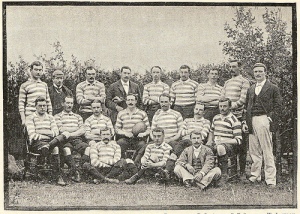
Rugby 1891 - "The best teams were undoubtedly the Western Provinces, played at Cape Town ; the Griqualand West (to whom the "Currie" Cup was given) at Kimberley" ...source:
rugby-pioneers.blogs.com/rugby/2008/09/touring-to-sout.html


Boer Women - image: nzhistory.net.nz

Boer Soldiers -image:nzhistory.net.nz

Boer Women:Image:ictnetwork.co.ukThe Scandal of the Black CampsA South African visitor to this site has raised the controversy about the imprisonment of Black South Africans in conditions much worse than those for Boer prisoners. Removed from farms or other areas, at least 14 000 Black people are believed to have died in these concentration camps--but for nearly a century the ordinary South African was completely unaware of their existence.
Unlike the Boer prison camps, the Black prisoners were mostly left to fend for themselves, and were not given any rations at all. They were expected to grow food or find work. In a few instances this actually improved their chances of survival because they were able to get out of the camps which were hellholes of infection and disease.
Source:http://users.westconnect.com.au/~ianmac5/exhibit8.html
[youtube=http://www.youtube.com/watch?v=Phoqx-MOXWs&]

Image: ToGoTo.co.za
Almost Forgotten Victims - The Anglo-Boer War Camps of Aliwal North
Southbound out of the Free State’s grassy plains, the Friendly N6 Route carries travellers across the great Senqu/Orange River into Aliwal North, gateway to the Eastern Cape.This quietly bustling provincial town was formally founded in 1850 by Sir Harry Smith, then governor of the Cape Colony, who named it in tribute to his 1846 victory over the Indian Sikhs at the Battle of Aliwal. “North” was added to differentiate it from Aliwal South, the old name for Mossel Bay. Fifty years later this hamlet would become the chosen site for two of the many horrific concentration camps of the Anglo-Boer War. Aliwal North’s Northern Post and Border News reported in January 1901 that a native refugee camp had been established at the confluence of the Orange and Kraai rivers for blacks impoverished by the war. The term “refugee” was bolstered by the fact that, initially, blacks entered the camp voluntarily, and also willingly supplied a virtually endless source of manpower for the “labour-strapped” colonial government. Towards the end of January the camp contained just over 200 refugees. At that stage the Aliwal North town council advised the Rouxville Commandant that the council could no longer cope with the Free State refugees – since the camp was a military undertaking, the council would help but would not take responsibility. In February, the council exhorted the authorities to give urgent attention to the poor sanitary conditions in the camp.According to Rev. Kessler, an American researcher on concentration camps, in August 1900 a British Intelligence officer, HR Abercrombie, recommended that defeated Boers, their families and servants should be sent to concentration camps similar to those used by General Weyler in Cuba in 1896/1897. Lord Roberts, the Supreme Commander, did not approve. However, when Lord Kitchener assumed this position, he incorporated the recommendation into his “scorched-earth policy” to end the guerrilla war. He planned to make it impossible for Boer commandos to receive any assistance from their families or the land by burning all their homes, razing crops, slaughtering all the animals and driving all black servants, Boer women and children into concentration camps.Kitchener initiated his campaign in mid-March. Within one month the black inmates had increased to over 2000 and a separate camp was established for them approximately 5 km lower down along the Orange. By May, the arrival of white women and children from the Free State villages of Rouxville, Zastron and Smithfield swelled the white camp population to over 2500; by October, when others were brought from Bloemfontein, the camp reached its maximum of almost 5000.In 1986, a local farmer, Mr Abrie Oosthuizen, suffered a severe heart attack and was given a year to live. Releasing the farm to his son, he retired to Aliwal North where he underwent a heart bypass operation. During his recovery, he found time hung heavy on his hands and he became bored. Then, Abrie enthusiastically started researching the Anglo-Boer War. The result was the publication of his first book, Rebelle van die Stormberge, six years later in 1992. After completing a second book, he turned to the military blockhouses and forts along the Orange River. In all his research, there had always been a gap – the history of the black war refugees: it seemed as if they had simply disappeared off the face of the earth. Until he came across an interesting and illuminating article in a copy of the Northern Post of 1902. It stated that the municipality had planned to construct a turbine pump station but was divided over a suitable site. One group suggested building it below Aliwal North beside the Orange River. The other preferred a higher position beside the Kraai River, since they feared contamination from the graves along these rivers. Eventually the camp superintendent provided proof that the graves were so deep that there was no likelihood of pollution. This controversy indicated that camp graves existed not only in the bend of the Kraai River above the confluence but also along the Orange River right up to Greathead’s Mill, where the pump station stands today. Abrie obtained further proof of a second camp while reading the research of Dr Jan Ploeger, the government archivist, wherein he noted that the black camp at Aliwal North had been moved five miles west of the white camp.Abrie Oosthuizen then heard of a Mr Michael Magetse who helped him identify the place through the fireside stories he had heard from his grandfather, a camp survivor. Abrie found the first camp and the remains of many black graves beside the Kraai River, which were confirmed by the land surveyor of Aliwal North, Mr N van Deventer. After a futile attempt to find the second camp, Abrie located an old map indicating a “native cemetery” five miles west of the first. It was described as Crown Land, ceded to the mayor and town council of Aliwal North in 1912 “on condition that the land hereby granted shall be used as a place of interment for Natives”. The title deed subsequently obtained from the office of the surveyor-general in Cape Town provided irrefutable proof that the one morgen terrain situated in the current township of Dukathole was the oldest formal graveyard for black people. Mr van Deventer had no trouble finding the anchor stones with rusted wire attached to them, indicating the corners of the fence surrounding the “native cemetery”. It is believed to be the first cemetery of its kind in South Africa which could be accurately located.Although a careful record was kept of white deaths, Emily Hobhouse, in her book The Brunt of the War, admits that statistics of black mortalities were scanty. Calculations based on the known number of black mortalities in Free State camps from July to October 1901, indicate that there were at least 250 to 270 black South Africans who died in the Aliwal North camp during those four months alone, mostly from pneumonia, enteric fever and diarrhoea. Conditions in the overpopulated camps had quickly deteriorated, since the little town of Aliwal North with only 800 inhabitants did not have adequate infrastructure to support the sudden influx of camp inhabitants.Two separate and magnificent monuments commemorate Aliwal North’s white victims of war; on one hilltop lies the Garden of Remembrance for 134 British and Colonial soldiers, on the other hilltop, the Concentration Camp Memorial Garden for the 720 Boer women and children who succumbed to the appalling conditions in the camps.A monument has been erected on the picturesque site of the original “Native Cemetery”, along the bank of a river that on its 2000 km long journey brings life and sustenance to vast tracts of our country and many of our people, irrespective of colour or circumstances. The original cemetery is surrounded by thousands of more recent graves extending over an area of at least five morgen. The respect with which this piece of land has been treated for over a century makes it a fitting memorial to those almost forgotten victims.Read the complete story in the June/July issue of ToGOToSource: http://www.togoto.co.za/?PID=2&fu=ReadArticle&gid=38&Issue=4

Subscribe to:
Posts (Atom)


